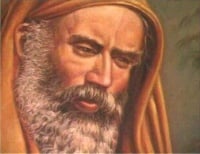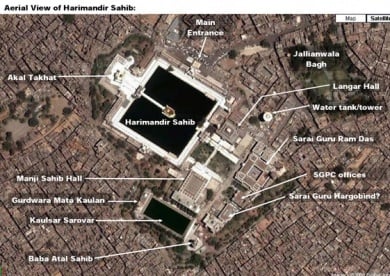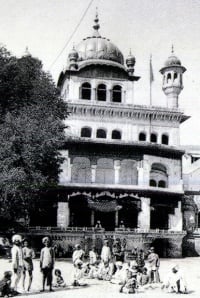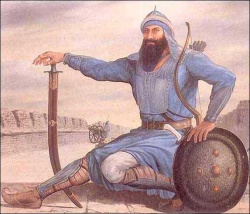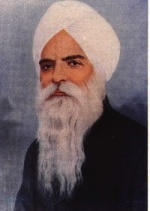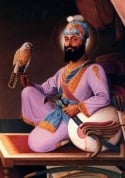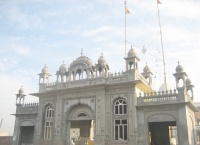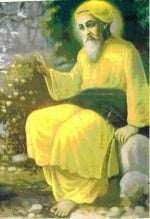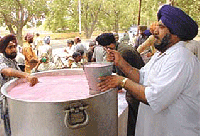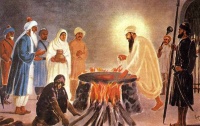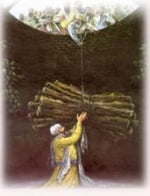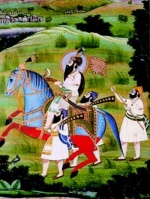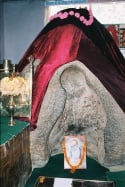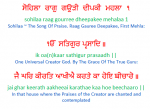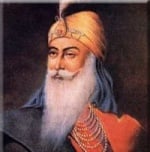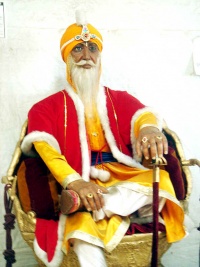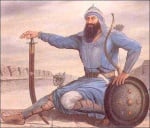SikhiWiki:Today's featured article/June 2009
Today's featured article archive
2007 -
2008 -
2009 -
2010 -
January - February - March - April - May - June - July - August - September - October - November - December
Today is Friday, April 19, 2024; it is now 14:52 UTC
Featured content:
| << | Today's featured articles for June 2009 | >> | ||||
| Su | Mo | Tu | We | Th | Fr | Sa |
| 1 | 2 | 3 | 4 | 5 | 6 | |
| 7 | 8 | 9 | 10 | 11 | 12 | 13 |
| 14 | 15 | 16 | 17 | 18 | 19 | 20 |
| 21 | 22 | 23 | 24 | 25 | 26 | 27 |
| 28 | 29 | 30 | ||||
- June 1
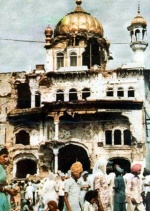
Operation Blue Star was the codename for the attack on the Akal Takhat and the Golden Temple complex during the period June 1 to 6, 1984. This tragic event took place over 25 years ago and Sikhs all over the world will remember this episode with great sadness.
The Indian army invaded the Harmandir sahib complex on the orders of the then Prime Minister of India, Indira Gandhi. At the time of the operation, close to 100,000 army troops had been deployed throughout Punjab.
A group of Sikhs, led by Jarnail Singh Bhindranwale (the charismatic leader of the Damdami Taksal) had, after being expelled from one of the Niwas (guest houses) moved into the Akal Takhat.
Besides the historic weapons carried by Sikhs, the kirpans and khandas, the group which had fortified the historic Takhat, with rifles, assault weapons & grenades, numbered no more than 250. The Golden Temple, the surrounding Bungas, guest houses and Langar were filled with 2,000 or more pilgrims, guests and employees of the complex. Many had come to visit the Temple on the day associated with the Martyrdom of Guru Arjan. .....More
view – talk – edit – history
- June 2
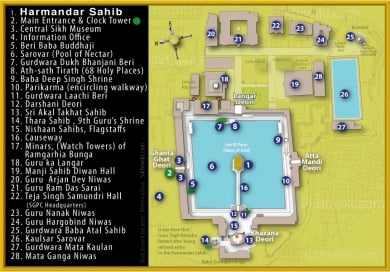
click on the plan to enlarge (by user:allenwalla)
The Golden Temple or Sri Harmandar Sahib is the most popular of all Sikh shrines. Sikh places of worship or Sikh shrines are called Gurdwaras. The Sri Harmandar Sahib is located in Amritsar in Punjab, North India.
Over the years the city has come to be known by the name of the Holy pool in which the Harmandar Sahib stands. Located in the center of the huge "Amritsar" (the pool of nectar) the Harmandar (sanctum sanctorum) symbolizes the synthesis of nirgun and sargun (the spiritual and temporal realms of human existence) for the Sikhs.
The "Mandar" is reached by a causeway from the `swarg dwarn' or Darshini Deori (gateway). .....More
view – talk – edit – history
- June 3
We should not increase our burden of karmas by eating higher life forms. There is karmic value in every kind of thing we use in this world. The air we consume, the water we use, we have to pay for.
The light of the sun or moon is also not free...and this green grass is also to be paid for - nothing is free. Everything has a Karmic value.
Depending on the "Jun" (life-form), there is a price to be paid. Lower life forms have a lower price to pay. Fruits and plants have a lower spiritual price than animal life forms. So why take the higher burden?
We now refer to this sensitivity with new and fancy words like "our green foot print", "environmentally friendly", "eco-friendly", etc. However, all these words narrow down to a way of life that does the least damage to the world.
If you are to construct a house, you don't make it using gold or silver or jewels. If you can, you make the house of stone - Stone is very strong and cheap. So, why don't you make your own house with stone and brick instead of gold? This body is like a house. .....More
view – talk – edit – history
- June 4
On the 4 June every year, the worldwide Sikh community celebrate the birthday of late Bhagat Puran Singh (1904 - 1992). Bhai Sahib was born at Rajewal, in district Ludhiana, Punjab, India on June 4, 1904.
His mother was Mehtab Kaur and his father's name was Chaudhari Chibu Mal. Bhai Sahib was born into a Hindu family and his original name was Ramji Das. He started his education at Khanna, Punjab and then later joined Lahore's Khalsa High School.
As a young man, he used to perform "sewa" at Gurdwara Dera Sahib and Gurdwara Shahid Ganj in Lahore. Here, he would help with cleaning, cooking and serving food; he also tended to the aged, infirm and sick who came to the Gurdwaras to pay their respect to Guru Granth Sahib.
In an interview with Bhai Patwant Singh, Bhagat Puran Singh discloses how he became a Sikh. In his early life he used to travel a lot from village to village and would stay overnight at a Hindu Temple. One day when he was staying at one such temple, the Brahmins told him to clean the temple and then when he had done that, they sat in front of him and started eating food without offering him anything.
The next time, he had to stay at a Gurdwara and the priest there not only gave him food but also a cot and a glass of milk afterwards .....More
view – talk – edit – history
- June 5
Harimandir Sahib is the most famous Sikh Temple or Gurdwara in the world. It is also called the Golden Temple in English because of the gold plating that covers most of its surface. This Gurdwara is found in the holy city of Amritsar in Punjab in North West India and is the sacred and the most visited of the many historic Sikhs shrines found in India and Pakistan. This striking building was built by the Guru Arjan Dev, the fifth Guru of the Sikhs.
For details of the Gurdwara itself see Gurudwara Harimandir Sahib. This articles deals with the area outside the Gurdwara precinct and immediate surrounding the holy shrine. It deals with the other Gurdwaras and places of interest found just outside the perimeter wall of the Gurdwara. .....More
view – talk – edit – history
- June 6
On June 1,1984, my brother Surinder and I were moved out of Punjab as the borders were being sealed and a curfew was declared in Punjab. Further, there was a news blackout. That only meant we had to infiltrate and see exactly what was going on.
So after two weeks, we set off in disguise. Upon approaching Amritsar, the truck we were riding in was waved to a stop and all of us were ordered out. I had already fastened my tape recorder with gaffer's tape to the small of my back. And I had tucked my 16mm Bolex camera into a filthy old jhola (cloth bag). When I raised my arms, a soldier patted me down but missed the tape recorder, and when he spun me around, I shifted the jhola quickly so he didn't see it under my shawl, and off we went to see what destruction Mrs. Gandhi had created.
Tanks and submachine guns and barbed wire greeted us at the Golden Temple. We circled around to the medieval streets in the back. Crooked winding lanes were dotted with Gurkha Regiment guards, imported because their foreignness would imply that they would not be taking sides in what was clearly the most traumatic event to have taken place in our lifetime in India.
"The police hacked off the arms of people and we collected their torsos in gunny sacks," said one of the residents who dared to greet us in the empty streets. He spoke in Punjabi, into my tape recorder. For half an hour, we interviewed him as he described the utter carnage of three days of gruesome battle that is now known with the rather beautiful name Operation Blue Star.
.....More
view – talk – edit – history
- June 7
The indiscriminate brutal killing, jailing and abusing of innocent Sikhs in Delhi and other major Indian cities following the death of Prime minister, Indira Gandhi on 31 October 1984, should be a reason for great shame and sadness for the authorities and politician of India and for all people of the nation.
It defeats belief, that in a civilised society, during the modern era, that Sikhs who are a section of the community; a small minority at that, can be blamed and summarily punished without any trial or open examination, for the evil actions of just two individuals; this is absolutely beyond comprehension or understanding; it is behaviour belonging to the Stone Age.
Shame on you, India! You may have made some material progress in the last sixty years but the standards of justice and fairness in your country definitely belong to the dark ages.
This horrible event clearly highlights the very low level of morality, the non-existent level of spiritual awareness, a complete lack of compassion and .....More
view – talk – edit – history
- June 8
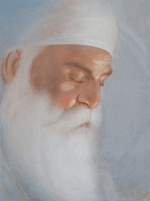
What is Sikhism? Sikhism is a way of life; a disciplined mode of living coupled with a belief in the presence and unity of one God, the equality of all mankind, dedicated faith in the Guru's word and love for all of humanity.
The stepping stone for a Sikh is to accept the one God and remember Him with ones mind and acknowledge Him through ones daily actions. A Sikh puts his trust in God alone rather than in other beings, relatives, wealth or possessions.
To act in His name and gradually reach a stage where, as the Guru says, "Water mingles with water and light merges in the light, discarding their separate existence."
Originality and clarity of the Sikh faith was instrumental in promoting it from its inception in about 1499 and the voluntary adoption by the masses with eagerness and whole-heartedness. "Keep the message simple" appears to be the common thread throughout Sikhi concepts. Simran - meditating and remembering the Creator and Seva - willingness to give ones labour for free - are the bedrocks of Sikhi. If you cannot focus your mind on the Lord; see God in all; believe in the Creator, then the journey is going to take a little longer. .....More
view – talk – edit – history
- June 9
Baba Banda Singh Bahadur (16 October, 1670 - 9 June, 1716) (Lachhman Dev alias Madho dass Bairagi), originally from the Jammu region in Northern India, is revered as one of greatest Sikh warriors as well as a most hallowed martyrs of the Khalsa Army.
The Khalsa were engaged in a prolonged fight against the cruel Mughals, who were practising their tyranny and terrorism. His confrontation with the Mughal administration in Northern India, though brief, was strong and vigorous enough to shake the foundations of this evil empire.
The agrarian uprising that he led in the Punjab was the underpinning on which the Dal Khalsa, the Sikh Misls and Maharaja Ranjit Singh built the edifice which finally culminated with Ranjit Singh capturing Lahore in 1799 and establishing the Sikh Kingdom of the Punjab; that resulted in the end of a dark period in the history of India.
Banda was born in a Minhas Rajput family on October 16, 1670 at Rajouri in the Jammu region of Jammu and Kashmir. He was named Lachman Dev. Wrestling, horseback riding, and hunting were his major hobbies. He was a very active and energetic child. .....More
view – talk – edit – history
- June 10
Bhai Vir Singh (5 December, 1872 - 10 June, 1957) was a poet, scholar and theologian who was a major figure in the movement for the revival and renewal of Punjabi literary tradition.
His identification with all the important concerns of modern Sikhism was so complete that he came to be canonized as Bhai, the Brother of the Sikh Order, very early in his career. For his pioneering work in its several different genres, he is acknowledged as the creator of modern Punjabi literature.
Born on 5 December 1872, in Amritsar, Bhai Vir Singh was the eldest of Dr Charan Singh's three sons. The family traces its ancestry back to Diwan Kaura Mall Arora (d.1752), who rose to the position of vice-governor of Multan, under Nawab Mir Mu'ln ul-Mulk, With the title of Maharaja Bahadur. Bhai Vir Singh was married at the age of 17 to Chatar Kaur, daughter of Sardar Narain Singh of Amritsar.
Considered to be the harbinger of modern Punjabi literature, Bhai Vir Singh wrote many books,prose, novels, poety, plays, historical research, novels and articles pertaining to the Sikh history, Gurbani and understanding of the Sikh principles. .....More
view – talk – edit – history
- June 11
On June 11 every year the Sikhs celebrate the Gurgadi day of their sixth Master, Guru Har Gobind (5 July 1595 - 19 March 1644).
The Guru sahib was born at village Guru Ki Wadali in district Amritsar, Punjab, India on 5 July 1595 and was the only son of Mata Ganga and Guru Arjan, whom he succeeded on 11 June 1606 at the age of only 11 years old.
The young Hargobind received his early education and training from the revered Sikh leaders of the time Baba Buddha, the first Sikh "granthi" and Bhai Gurdas, the scribe of the Sikh holy script, Guru Granth Sahib.
Guru Hargobind was married in about 1610 to Mata Nanaki also known as Mata Marwahi or Mata Mahadevi. They were endowed with a large family consisting of one daughter Bibi Viro and five sons: Baba Gurditta, Suraj Mal ji, Ani Rai ji, Atal Rai ji and Tegh Bahadar ji. Guru Hargobind was responsible for wearing two kirpans - one for Miri (temporal protection) and one for Piri (spiritual elevation) and began the rapid and irreversible militarization of the Sikh people. It was due to the tragic martyrdom of his father, Guru Arjan that the sixth Guru changed the Panth (the global Sikh community) into an effective, brave and determined army of religious supporters of righteousness (Dharam).
The Guru also built the Akal Takhat in 1608 - which is now one of five takhats (seats of power) of the Sikhs and is the place from where worldwide direction is given to the Sikh community on global issues. Guru sahib also founded the city of Kiratpur in District Rupnagar, Punjab. .....More
view – talk – edit – history
- June 12
The Battle of Amritsar took places between Guru Hargobind and the Mughal forces and was fought on 5 June 1628 (22 of Jeth, in Bikrami 1685). This was the first battle fought by the Sikhs.
Mughal Emperor, Jahangir had died in 1627 with his son Shah Jahan becoming his successor. Adding to Shah Jahan's worries over the increasing influence and power of the Sikhs, those who harboured ill-will against the Sikhs renewed their conspiracies and incited him to turn against Guru Ji.
The battle started due to a minor event that took place in the jungle about 5 miles to the south of Amritsar. It all began with the capture of a rare white Baz (hawk) which had been a gift to Shah Jahan from the Shah (Emperor) of Persia. The hawk was at the time one of the royal symbols of authority.
Shah Jahan and some of his companions were hunting in the territory around Gumtala village near Amritsar at the same time as some of the Guru's Sikhs. .....More
view – talk – edit – history
- June 13
In the 15th century Sir Nicholas Bacon, a member of Corpus Christi College Cambridge gave modern science its first born son, in the days when Elizabethan England flourished at its peak.
When that son Francis Bacon (1561 – 1626), a member of Trinity College Cambridge became Lord Chancellor, the highest law officer in England, he was already recognised as a philosopher. He was endowed with the wisdom of universal thought. He then laid the foundation of modern science.
The great Renaissance of learning began with Roger Bacon (1214–1294) in the 13th century. The torch of genius was then taken up by Leonardo da Vinci (1452 – 1519). It was thrown into the sky by Galileo (1564 – 1642) and Copernicus (1473 – 1543). Christopher Columbus (1451 – 1506) had entered the far horizons of one of the world's mighty oceans.
At about the same time Guru Nanak (1469 AD) who founded the Sikh religion, was doing the same and more in the sub continent. On the science front, Nanak told us the distance to the moon which is exactly what the scientists tell us today. He also disclosed that there are universes upon universes, and spheres upon spheres and many planets had existence like ours. .....More
view – talk – edit – history
- June 14
On June 16 every year, Sikhs worldwide celebrate - yeah, Celebrate! - the great sacrifice of Guru Arjan, their fifth Guru.
In 1601, after completing the construction of the beautiful Harimandir Sahib and then the successful compilation of the voluminous sacred Sikh Scripture called the Adi Granth in 1604, the Guru embarked on teaching the Sikhs his ultimate lesson.
In 1606, the Guru, by example, showed the Sikhs the way and the manner in which to die in the name and in the Hukam (will) of God. Guru ji was the first Sikh martyr ever and by this event, the Guru set a precedence and an example for the people of the world.
He demonstrated how one should lay down one's life without fear, with dignity, honour and how not to be intimidated by thugs and terrorists. ....More
view – talk – edit – history
- June 15

(photo:Prabhu Singh)
Harh (the Guru calls this month "Aasaarh" (Gurmukhi: ਆਸਾੜੁ)) is the fourth month in the Nanakshahi calendar. This month coincides with June/July of the Western/Georgian/Julian Calendar and is 31 days in length.
The month begin on June 15 and ends on July 15. On July 16, begins the fifth month in the Sikh Calendar called Sawan.
During this month of Harh, in Punjab, the land of the Sikh Gurus the season is summer and the climate is hot to very hot. Most westerners will have left the area as the temperatures are in the high 30 degrees centigrade.
The Guru tells us that the month of Harh (June/July): ".... seems burning hot, to those who are not close to their Husband Lord. They have forsaken God the Primal Being, the Life of the World, and they have come to rely upon mere mortals. In the love of duality, the soul-bride is ruined; around her neck she wears the noose of Death. As you plant, so shall you harvest; your destiny is recorded on your forehead. The life-night passes away, and in the end, one comes to regret and repent, and then depart with no hope at all. Those who meet with the Holy Saints are liberated in the Court of the Lord. Show Your Mercy to me, O God; I am thirsty for the Blessed Vision of Your Darshan. Without You, God, there is no other at all. This is Nanak's humble prayer. The month of Aasaarh is pleasant, when the Feet of the Lord abide in the mind. ||5||" (SGGS page 134) .....More
view – talk – edit – history
- June 16
On 16 June of every year since 1606, the Sikhs have commemorated the martyrdom of their first martyr, the fifth Guru, Guru Arjan Dev. Sikh history until then had been peaceful and non-violent.
All the Sikh Gurus had taught the message of compassion, love, dedication, hard work, worship of one God and the commitment to peace and harmony for all the peoples of the world. During the Guruship of Guru Arjan many thousands of the native people had began to follow the teachings of Sikhism and both the Hindus and Muslims were crowding to Govindwal, the centre of Sikhs during the late 1500's.
After the death of Mughal Emperor Akbar in 1605, his son Jahangir became the leader of India. Unlike his father, Jahagir was a fundamentalist Muslim, obsessed with turning the country into an Islamic state. Both Hindu and Muslim fundamentalists concerned at the rapid increase in the popularity of Guru Arjan, moved the new head of state Emperor Jahangir against the Guru. Jahangir himself was also jealous about Guru's propagation of Sikhism.
He promptly obliged the enemies of the Guru. Many baseless allegations were levelled against Guru Sahib, one of those was helping the rebellious Khusrau, who was Jahangir's son and the preferred choice of Akbar to be the next ruler of India rather than his son Jahangir, who was given to drinking wine and taking opium. .....More
view – talk – edit – history
- June 17

photo courtesy bbc
On February 5, 2008, at a preliminary hearing, a UK judge Sir Michael Harrison in Court 18 at the Royal Court of Justice in London decided not to allow a Sikh girl, Sarika Watkins-Singh to wear her Kara to school.
The Kara is one of the five articles of faith which is worn by all practising Sikhs. The decision was made before the case was heard at a full hearing several months later.
Fortunately, when the case was heard at a full trial by Mr Justice Silber, over 3 days from 17 June, 2008, he sided with the Sikh girl.
The deputy High Court judge decision at the first hearing was surprising as in 1983 the House of Lords, the supreme court in the UK decided that a school had violated the rights of a student, Gurinder Singh Mandla when he was not allowed to join the school because of his turban which he used to cover his kesh (uncut hair); one of the 5ks or Articles of faith. (see the full judgement Mandla v Dowell Lee).
In what appears an unbelievable statement, the deputy judge ruled: "Whilst I accept there will be detriment to the claimant (Sarika) if she is not able to wear the Kara in the interim, it does not seem to me that is anything like as significant as the detriment to the school if she were allowed to wear it."
This surprised a lot of Sikhs as it appears to encourage other organisations to freely discriminate and break the law as the "detriment to the claimant" may be less significant than to the opposite party. .....More
view – talk – edit – history
- June 18
Bhai Manjh In the time of Guru Arjan Dev ji, there was a powerful and rich Jatt by the name of Teeratha. Teeratha was a follower of the Muslim sect of Sakhee Sarvar.
He was the local leader of this sect and had hundreds of followers who all respected him. Teeratha would regularly lead the members of this sect on a pilgrimage to the main Sakhee Sarvar shrine now in Pakistan
Once when passing through Amritsar, Teeratha decided to visit Guru Arjan. He had heard that there was a great Guru who had a large following and this Guru was spiritually enlightened.
He was curious to know who this Guru was and what he would say. He decided to stop off and see the Darbar of Guru Arjan. When he saw the Darbar, he saw that people of many different backgrounds, and castes were all sitting together and living in harmony. He also heard the kirtan in the darbar and the kirtan left a permanent mark on him. He heard of the great gift of naam and the thirst to have this gift rose within him. He was the leader of hundreds of "Sakhee Sarvar" followers but he could no longer follow that path. He realised that Sikhi was the path he must follow. .....More
view – talk – edit – history
- June 19

by Guru Arjan
A cousin of Guru Ram Das came to Amritsar from Lahore especially to ask Guru Sahib to attend his son's wedding. Guru ji said, "I will not be able to go because I can't leave my duties here as Guru. Perhaps I can send one of my sons instead."
Guru Ram Das ji had three sons: Baba Prithi Chand or Prithia, Baba Mahadev and Arjan Mal. Prithia was in charge of collecting donations, of which he secretly took a portion for himself. When the Guru asked him to attend the wedding, Prithia said, "I have to take care of the collections. And I hate going to weddings."
Actually, he was afraid if he were away from the Guru for too long, he might not be appointed the Guru's successor. Having no luck with Prithia, Guru Ji then turned to Mahadev. Mahadev lived his life in meditation and said, "I have no desire to involve myself in worldly affairs."
Finally, Guru Sahib asked Arjan if he would go. Arjan said, "I only desire to do what you wish." Guru ji was very pleased. He asked Arjan to spend some time in Lahore to share the Guru's teachings with the Sikhs there. Any donations he received were to be given to the free kitchen to feed the poor. The last words he said to Arjan were, "You should stay in Lahore until I send for you by letter." .....More
view – talk – edit – history
- June 20

Most people in the west who wear the turban are Sikhs. All Sikhs, but particularly male Singhs are required to don the Dastaar due to the pronouncement in 1699 by the tenth Sikh master, Guru Gobind Singh.
"Dastaar", is the native Punjabi term used to refer to this headdress. Even 300 years on, it is in compliance to the Hukam (or order) of this supreme Sikh leader that all Sikhs today wear the dastaar. It is in honour and obedience to this one person!
The Sikh prime minister of India, Dr Manmohan Singh, displays his sky blue trademark turban out of respect for the Sikh Guru; the famous record breaking, 95-year-old marathon runner, Fauja Singh proudly wears his dastaar in honour of the tenth Sikh teacher; Bhagat Puran Singh the humble humanist and philanthropist used to don a simple turban in respect of the Sikh master. Why do the Sikhs go to all this trouble so many years after the diktat?
The dastaar comes in many different colours and styles and to the keen eye, each turban is different. Some are simple but regal; others may be bright and sporty; yet others may be stylish and extravagant – each one has it own special and unique statement. Every morning, most Sikh man and many Sikh women, spend some 5 to 20 minutes to comb their long hair and then carefully handicraft the link to their Gurus – a daily reminder of their heritage and its responsibilities. .....More
view – talk – edit – history
- June 21
Guru Gobind Singh was famous for his blue coloured horse. In fact Guru Sahib is sometimes known as "Neelay ghoray whalla" or "one with the blue horse" and many a folk songs and vars sing the exploits of "Neelay ghoray they swaar" or "the rider of the blue horse". Just as his grandfather Guru Hargobind sahib had done, Guru Gobind Singh instructed his Sikhs to make offerings of arms and horses in readiness for the turbulent times ahead. In anticipation of this Guru Gobind Singh learnt the art of horsemanship from an early age under the guidance of his maternal uncle, Bhai Kirpal Chand.
As Guru Sahib grew older, he became an accomplished horseman and would spend time travelling the country-side on horseback blessing his people who would inevitably gather wherever he went. It is not clear where the blue horse, affectionately known as Neela (meaning "blue"), was acquired from. It may have been a gift from a royal dignitary or from a devotee. Even today the lineage of the stallions continues at Hazoor Sahib, Nanded.
The horses are kept in stables and are descendants of the original stallion of Guru Gobind Singh, although over time the blue colour has been diluted down to a grey white. No one is allowed to ride the horses as a mark of respect and they are brought out on the festival of Holla Mahalla or gurpurbs when they are beautifully decorated with tassels and riding gear.
On occasions, especially on the festival of Holla Mahalla, it has been said that the horse will get extremely sweaty and agitated, as if it is being ridden. It is difficult to get information about Guru Sahib’s horse, even more so about a blue horse. These horses are very rare and many people are sceptical that such horses exist. .....More
view – talk – edit – history
- June 22
The old saying "An Eye for an Eye and a Tooth for a Tooth" is world famous and unfortunately this quotation is still frequently followed and practised by many individuals and societies around the planet. These folks consider revenge as sweet recourse for any wrong done on them.
To act in vengeance for any wrong done has been considered the right way to live their lives. For any wrong done, they will do a similar or in most cases a bigger wrong; this reaction takes place frequently and is automatic; without any thought or consideration; to these folks it is the norm to be followed.
But as Martin Luther King Jr. said, "That old law about "an eye for an eye" leaves everybody blind. The time is always right to do the right thing."
If we think carefully about this, then in a society which practises this principle of "an eye for an eye", one injury will create a "domino effect"; and you know what happens in a domino reaction. Wikipedia defines domino effect as "a chain reaction that occurs when a small change causes a similar change nearby, which then will cause another similar change, and so on in linear sequence" until, I presume, there is nothing left nearby!
So, yes, if everyone follows this commendation, then all of us will end up totally blind when a single injury has been inflicted by anyone! Is this a Sikhi thing to do? .....More
view – talk – edit – history
- June 23
Ek Onkar: This is the symbol representing the "One Supreme Reality" or "One God"
This fundamental teaching of Sikhism that there is only one Essence or one reality that sustains all is paramount to the understanding of Sikh beliefs.
Bhai Gurdas ji says of Ek-Onkar:
By writing 1 (One) in the beginning, it has been shown that Oankar, God, who subsumes all forms in Him is only one (as opposed to the two or three of Christianity or Siva, Bhrama and Vishnu or the thousands of Hinduism).
Ura, the first Gurmukhi letter, in the form of Oankar shows the world controlling power of that one Lord...
Ek Onkar symbolises "God is One." The symbol is an emblem of the Sikh religion and is found on Gurdwaras (Sikh temples) around the world. The symbol forms the cornerstone of Sikh belief in the unity and oneness of God. Ek Onkar is the beginning of the Sikh Mool mantra, the first word of the Sikh Holy book, the Guru Granth Sahib. .....More
view – talk – edit – history
- June 24
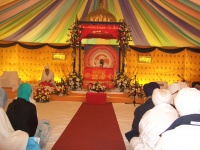
All visitors to a Sikh Gurdwara should be aware of the following guidelines when visiting:
- Please dress appropriately so that you can comfortably and with decency sit on the carpeted floor. It is recommended that all visitors to the Gurdwara wear loose fitting clothing which covers most of your legs. Low hanging or tight-fitting pants/trousers may not be suitable. Please try sitting on the carpeted floor at home for a short period to see if the clothing is suitable.
- All visitors entering the Main Prayer Hall, called the Darbar Sahib and the Dining (Langar) Hall will have to remove their shoes and place them in the shoe racks provided.
- Strictly No Smoking is allowed in the vicinity of the Gurdwara premises. Visitors cannot enter the Gurdwara while under the influence of Alcohol or Drugs. You should not take cigarettes or tobacco with you into the premises or smoke while near the Gurdwara or soon before going into the Gurdwara.
- All visitors MUST cover their heads while in the main Gurdwara areas ie: (Darbar Sahib and Langar Hall) .....More
- June 25
Gurdwara Pathar Sahib, is a beautiful Gurudwara sahib constructed in the memory of Guru Nanak, about 25 miles away from Leh, on the Leh-Kargil road, 12000 ft above sea level.
The Gurdwara was built in 1517 to commemorate the visit to the Ladakh region of Guru Nanak Dev, the founder Guru of the Sikh faith.
During his lifetime Guru Nanak travelled to many distant places and one such place was Tibet. Guru Nanak is well respected by Tibetan Buddhists who consider him a saint; The Dalai Lama, spiritual leader of Buddhists in Tibet, has confirmed this in his discussions with some Sikh leaders saying that Tibetans revere Guru Nanak as a Buddhist saint under the name of Guru Gompka Maharaj.
Discovery: In the late 1970s, during the construction of the Leh-Nimu road, a large boulder was found by Lamas in the middle of the road bed covered with Buddhists prayer flags. .....More
view – talk – edit – history
- June 26
Kirtan Sohila: This is the night time prayer said by all Sikhs before they go to sleep.
Three Sikh Gurus – Guru Nanak, Guru Ram Das and Guru Arjan - contributed five shabads in total to this bani on the pain of separation and celebrating the bliss of union.
The first three shabads were uttered by Guru Nanak and the fourth by Guru Ram Das and fifth by Guru Arjan Dev. It is the most harmonious Naad ever uttered. It multiplies the aura to the sensitivity of protection that it eliminates any negativity for miles and miles.
When you are endangered by any species of direct or indirect source; when you want to protect yourself with the surrounding of the entire magnetic field of the earth, recite Kirtan Sohila. It is a cure for Insomnia! The religious and artistic value of these hymns is superb.
- June 27
Maharaja Ranjit Singh (13th November 1780 - 27 June 1839) also called "Sher-e-Punjab" ("The Lion of Punjab") was the Sikh ruler of the sovereign country of Punjab and the Sikh Empire from about 1799. His Samadhi (memorial) is located in Lahore, Pakistan.
Maharaja was born in 1780 in Gujranwala in modern day Pakistan, into the Sansi-Sandhawalia family. At the time, much of Punjab was ruled by the Sikhs, who had divided the territory among factions known as Misls.
Ranjit Singh's father Maha Singh was the commander of the Sukerchakia misl and controlled a territory in west Punjab based around his headquarters at Gujranwala. Ranjit Singh succeeded his father at the young age of 12.
After several campaigns, his rivals accepted him as their leader, and he united the Sikh factions into one state and he took the title of Maharaja on April 12 1801 (to coincide with Baisakhi day), with Lahore serving as his capital from 1799. In 1802 he took control of the holy city of Amritsar. He brought law and order, yet was reluctant to use the death penalty. He stopped India's non-secular style and practises. He treated both Hindus and Muslims equally. He banned the discriminatory "jizya" tax on Hindus and Sikhs which had been imposed by the previous administration. .....More
view – talk – edit – history
- June 28
The early years of the 19th century witnessed the power of the Durrani declining.
Maharaja Ranjit Singh was encroaching the Afghan Kingdom and the Maharaja was eager to avail himself of any opportunity to snatch the rich province from the Durranis, the rulers of Afghanistan.
An opportunity came to Maharaja Ranjit Singh, when he annexed Attock in 1813 from the Afghans. But his initial attempts of 1814 and 1815 to seize Kashmir failed miserably. But then another opportunity arrived in 1819 when a Kashmiri Pandit, Birbal Dhar, a revenue collector of the Valley under the Afghans, escaped first to Jammu and then to Lahore and urged the Sikh ruler to free the Kashmiris from the Afghan’s oppression.
Sikh forces under the command of Missar Diwan Chand and properly guided by Birbal Dhar and Mian Gulab Singh invaded the Valley in 1819 A.D. Jabbar Khan the acting Governor of Kashmir collected his troops and faced the Sikh army but he failed to stop the onslaught of the Sikh forces. .....More
view – talk – edit – history
- June 29
Jaap is the bani (set of hymns) uttered by Guru Gobind Singh ji, the Tenth Sikh Guru, the Tenth Nanak.
It is one of the Five Banis recited by most practising Sikhs each morning and the bani that the Panj Pyare recite while preparing Amrit on the occasion of Amrit Sanchaar (Sikh Initiation), a ceremony held to admit initiates into the Khalsa "Brotherhood". It is the second bani of the five in the daily morning prayers routine of a Sikh.
The Lord is One and He can be attained through the grace of the true Guru, The Lord is One and the victory is of the Lord.
Jaap (Name of the Bani) - The sacred utterance of The Tenth Sovereign (Guru Gobind Singh)
Chhapai Chhand, Tva Prasaad: Chhapai style of verses, by Thy Grace
1. O Lord,
Thou art without any form, symbol, caste, class or lineage.
None can describe Thy form, hue, garb or shape.
Eternal and immutable,
Resplendent in Thine own Light,
Thy Power is without any limit.
Thou art the Lord of all Indras and the King of all kings.
Sovereign of the three worlds, .....More
view – talk – edit – history
- June 30
Conquest of Sadhora or Sadhaura was a conquest in 1709 by Banda Singh Bahadur of the area around Sadhaura. He fought with Nawab Usman Khan who had tortured and killed Pir Buddhu Shah.
Peer Buddhu Shah (13 June 1647 - 21 March 1704), a Muslim divine whose real name was Badr ud Din, was not only an admirer but also a staunch ally of Guru Gobind Singh.
During the Battle of Bhangani, Pir Budhu Shah came to the Guru's aid with his seven hundred followers, four sons and two brothers. The Guru had witnessed his dedication and support for the Sikh cause.
Banda Singh Bahadur avenged the Pir's execution in 1709 by storming Sadhaura and killing 'Usman Khan. Ancestral house of Pir Buddhu Shah in Sadhaura was converted into a Gurdwara named after Pir Buddhu Shah. Sikhs of Labana community belonging to nearby Ladhora village played an important role in this conquest.
A strange thing happened when the Muslim conquerors reached India. .....More
view – talk – edit – history

